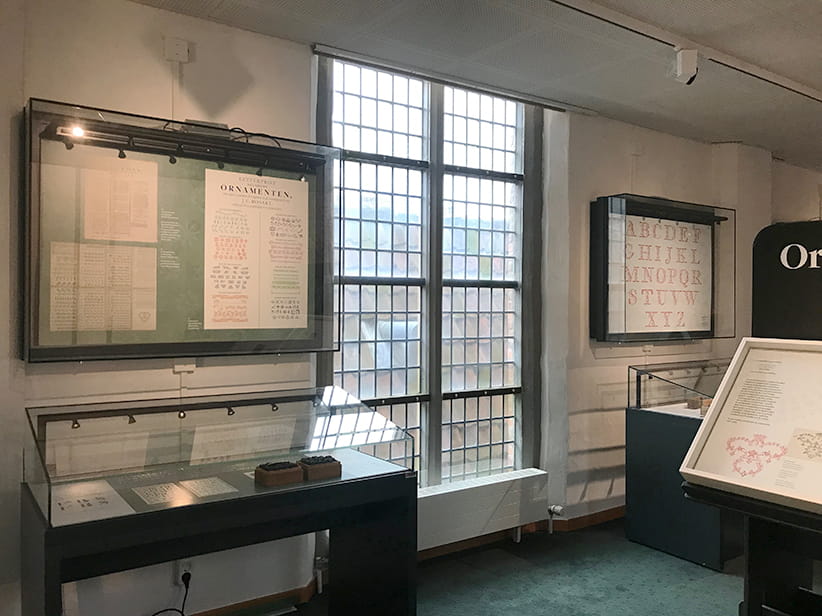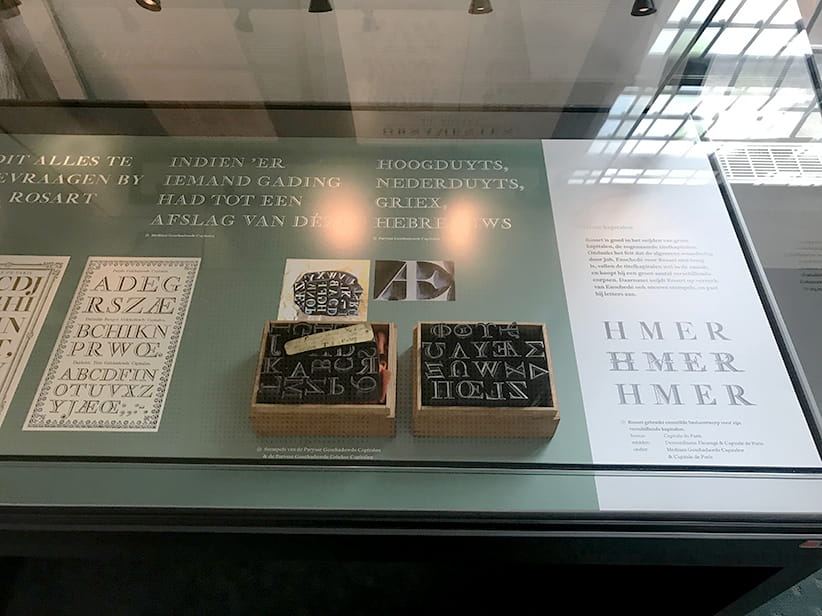see dtl’s ExquisiteFonts website!
| Home | Search | Site index | About | Contact |

Frontispiece showing Jacques-François Rosart
Jacques-François Rosart (1714–1777) was a very talented and prolific punchcutter from the Southern Netherlands. He mainly worked in Haarlem, Holland, and in Brussels, Belgium. Although born during the Baroque, the largest part of Rosart’s working career was during the Rococo and even early Neoclassicism. After all, his most famous type specimen was published in 1768. Hence, Rosart’s types show a mix of elements and details from these style periods.
Rosart’s place in the history of type design has been a bit underexposed, especially considering the fact that he was highly important for the printing industry in Belgium in the 18th century. His œuvre includes a tremendous number of type designs, spanning from hundreds of typographical ornaments, over various flourished capitals to several typefaces for text and display.

Michel Paré
In the second half of the 1990s the Dutch Type Library started working on a revival based on Rosart’s ‘Missel Romain’ and ‘Missel Italique’ under the guidance of Dr. Frank E. Blokland. For this, one of the three copies of Rosart’s 1768 type specimen from the collection of the Royal Library of Brussels was integrally scanned at dtl’s Studio. Interestingly, this was the same copy that was reproduced in the facsimile with annotations from Fernand Baudin and Netty Hoeflake published in 1973. Based on this digital material an initial set of working drawings was created for manual digitizing in ikarus format at dtl.

Walda Verbaenen
Twenty years later this is an ongoing project still and more recently it was enhanced with a collaboration of five laureates of the Expert class Type design (EcTd) 2014-2015 course at the Plantin Institute of Typography in Antwerp, which is taught by Blokland. The laureates work together on a huge part of the project for several years now: the production of a series of digital text and display types, florished capitals, and ornaments based on punches, matrices, and foundry type manufactured by Rosart.

Meeting with Revolver Type Foundry’s Lukas Schneider (centre) in The Hague
This enterprise will result in an extensive collection of fonts: eight weight/styles based on Rosart’s text and display fonts will be published by the Revolver Type Foundry of Lukas Schneider, who will also produce them. Besides these fonts, more than 800 ornaments and four different florished capital sets will be released by the Dutch Type Library. These fonts are made by Walda Verbaenen and Michel Paré. In addition, two booklets will be published: one specifically on the ornaments and one in which a number of type specimen of the text-, display- and florished capitals will be included together with an explanation of the research and production processes.
Most of the original type-foundry material from Rosart is currently stored at the Museum Enschedé, which is nowadays part of the Noord-Hollands Archive in Haarlem, Holland. After all, during the 18th century the printing firm Joh. Enschedé housed the most important type foundry in the Netherlands. However, the group EcTd-laureates started their projects with investigating historical material from Rosart in the collection of the Museum Plantin-Moretus in Antwerp, Belgium. Punches, matrices, and foundry type are intensively studied, accurately documented and reproduced into detail. The use of historical material as a manner to gain insight in the basis of, and relationship with the present-day practice of the type designer will be discussed in aforementioned booklets on Rosart’s ornaments, text- and display typefaces, and florished capitals.

Punches from
Rosart

Original Rosart ‘Fleuragé’ punches from the Museum Enschedé collection
One could question what the value of a revival is in a time in which more and more typefaces are developed. More specifically: what is exactly the added value of Rosart’s type? In his own time he was, for example, not considered of the same level as his famous contemporary Johann Michael Fleischmann, whose types formed the basis for dtl Fleischmann. Also, centuries later Daniel Berkely Updike was far from positive about Rosart’s œuvre in Printing Types: Their History, Forms, and Use (1922). However, reviving Rosart’s work undoubtedly adds to the richness of the present-day digital typographic palette because of the specific unique qualities of his œuvre.

Michel Paré investigating details in original Fleuragé punches from Rosart
This set of digital revivals may not be the first based on Rosart’s types, but it is definitely the most extended revival project in this category ever: not only of Rosart’s type but of any 18th-century punchcutter’s work.


Rosart exhibition in the public center of the Noord-Hollands Archief
The new research has led to a better understanding of this gifted autodidact, as well as digital revivals of various type models –originally more than 250 years old. The results can be seen in the Janskerk, the public center of the Noord-Hollands Archief in the city of Haarlem. The exhibition runs until June 30, 2023.
Search | Site index | Contact | Terms of use | Trademarks | Acknowledgements
Last update: 18 November 2024. Copyright © Dutch Type Library, 1998–2024. All rights reserved
dtl Headquarters | Zwaenenstede 49 | 5221 kc ’s-Hertogenbosch | The Netherlands
dtl Studio | Daliënwaerd 71 | 5221 ke ’s-Hertogenbosch | The Netherlands
phone: +31 (0)73 614 95 36 | fax: +31 (0)73 613 98 23 | e-mail: info@dutchtypelibrary.com